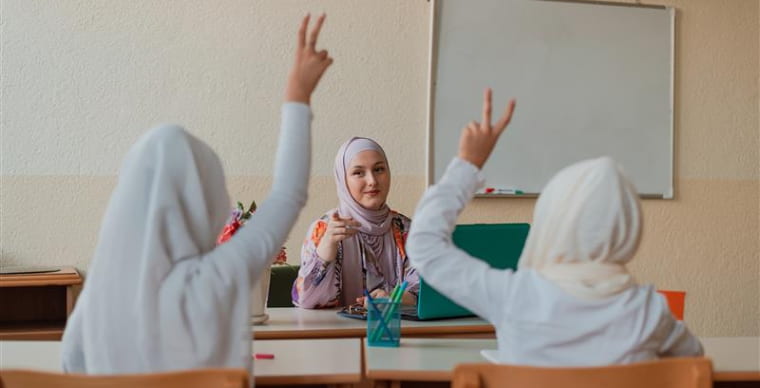The Arabic language is spoken by more than 400 million people worldwide, and is incredibly expressive and rich. Whether you’re learning it for academic reasons, work, travel, or cultural appreciation, the journey to fluency can be both rewarding and challenging.
Many learners find themselves hitting roadblocks when trying to master Arabic—but the good news is, those challenges aren’t impossible to overcome. With the right approach, support, and structure, anyone can make meaningful progress.
Let’s explore five of the most common challenges learners face when learning Arabic—and how the right learning environment, like the one we offer at Olive Education, can make all the difference.
1. The Arabic Language Script Can Feel Intimidating
The Arabic script is one of the initial challenges for students. It is written from right to left, and the form of several characters varies according to where they are in a word. For someone who is not experienced with non-Latin scripts, it may appear to be a significant obstacle.
Why it feels hard:- Letters look very different in isolation versus in a word.
- Vowels are often omitted in casual writing.
- Handwritten and typed Arabic can vary widely.
At Olive Education, we break the script down step-by-step. Instead of overwhelming students with memorization, we focus on pattern recognition and guided writing practice. Through interactive sessions and visual learning tools, students become comfortable reading and writing Arabic in a short period—building confidence from day one.
2. Understanding the Difference Between Spoken and Classical Arabic Language
Arabic is a dialect language, meaning it has two forms: Modern Standard Arabic (MSA), used in media and formal writing, and regional dialects (like Egyptian, Levantine, Gulf Arabic, etc.) used in everyday conversation. Many learners struggle to understand which one to focus on.
Why it feels hard:- You might learn MSA in class, but then hear something totally different on the street.
- Regional differences in dialects can be considerable.
- Native speakers switch between them effortlessly—but learners often feel lost.
Our Arabic Course Sharjah at Olive Education gives learners a balanced foundation. We teach MSA for literacy, grammar, and formal use, but also include practical training in commonly spoken dialects. Depending on your goal—academic, conversational, or business—we tailor the content so you’re not just learning rules, you’re learning real-world communication.
3. Complex Grammar and Sentence Structure
Arabic grammar is known for its complexity, especially verb conjugations, noun-adjective agreements, and case endings. Memorizing Grammar Tables makes many learners feel overwhelmed.
Why it feels hard:- Verb roots and patterns can feel unfamiliar to English speakers.
- Dual forms (in addition to singular and plural) add an extra layer.
- Word order can differ from what learners are used to.
Instead of teaching grammar in isolation, our instructors at Olive Education use contextual and immersive learning techniques. We teach grammar through stories, dialogues, and roleplays—making the structure feel natural instead of mechanical. This approach helps learners internalize patterns rather than just memorize them.
4. Pronunciation and Sounds That Don’t Exist in English
Arabic includes sounds like “ع” (ayn) and “ق” (qaf), which don’t exist in English. It also distinguishes between subtly different sounds, such as ح (ḥ) and ه (h), or س (s) and ص (ṣ).
Why it feels hard:- These sounds can be difficult to hear or produce at first.
- Mispronunciations can change meanings entirely.
- Learners may feel self-conscious speaking aloud.
Our courses emphasize pronunciation from the very beginning. We use audio drills, listening exercises, and one-on-one speaking practice to help learners develop the right muscle memory. Our native-speaking instructors provide direct feedback, gently correcting errors and helping you build clarity and confidence in speech.
5. Staying Motivated Over the Long Term
Arabic isn’t a language you master overnight. The learning curve is real—and many students struggle with consistency, especially when progress feels slow.
Why it feels hard:- It can take months to start feeling comfortable in conversation.
- Without a clear roadmap, motivation can drop.
- Traditional methods can feel repetitive or uninspiring.
At Olive Education, we know that motivation is key. That’s why our courses are designed to be engaging, goal-oriented, and supportive. Whether you’re learning in a group or one-on-one, we help you set achievable milestones and celebrate every small win. Our supportive learning community, engaging lessons, and interactive materials keep learners inspired throughout their journey.
For Successful Arabic Language Learning
For Successful Arabic Learning and enhance your learning, keep these tips in mind and practice:
Consistency beats intensity.
Don’t prepare once a week; practice a bit each day.
Use Arabic Language in your daily life.
Label items at home, write journal entries, or change your phone’s language settings.
Immerse yourself.
Listen to Arabic music, watch Arabic news or series with subtitles, and follow Arabic social media pages.
Record yourself.
Hearing your progress over time can be incredibly motivating. Be patient. It’s okay to struggle. Every Arabic speaker today once struggled with the same basics you’re facing.
Final Thoughts: Why the Right Support Matters
Although learning Arabic might appear difficult, it doesn’t have to be. Every language has its quirks—but with the right strategy, structure, and support system, anyone can succeed.
At Olive Education’s Arabic Language Training Sharjah, we’re committed to helping learners overcome these common challenges through structured curriculum, personalized support, and real-world practice. Whether you’re a complete beginner or looking to sharpen your skills, our Arabic courses are designed to meet you where you are and help you grow with confidence.
Start your Arabic learning training journey with us today—because learning a new language is not just about words, it’s about connection, culture, and personal growth.






